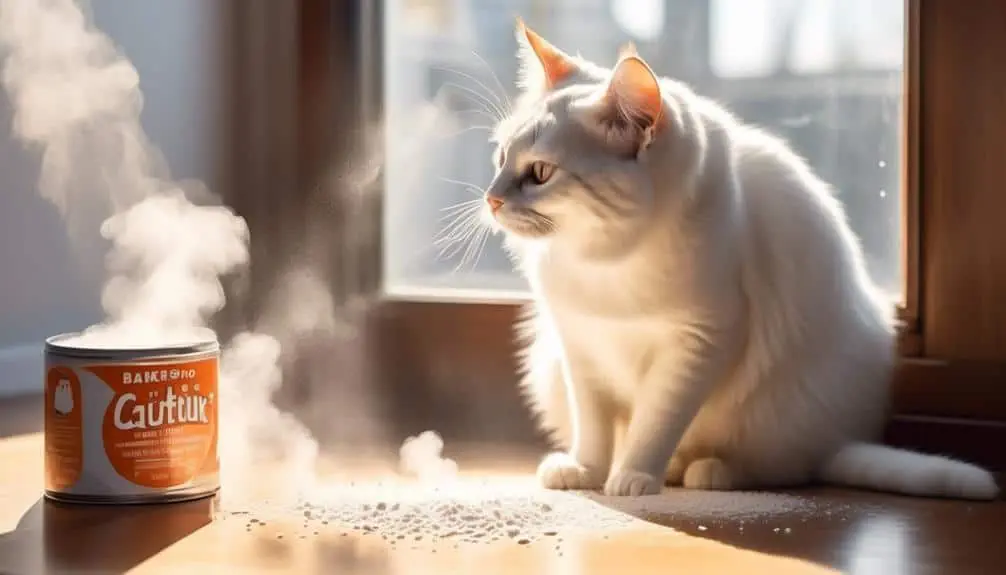The Best Fluffy Pancakes recipe you will fall in love with. Full of tips and tricks to help you make the best pancakes.

Are you a cat owner who has been wondering whether baking soda is harmful or helpful for your feline companion? Well, wonder no more. In this discussion, we will explore the potential risks and benefits of using baking soda around cats.
You'll discover the dangers of ingestion, the proper usage in litter boxes, and even its potential role in flea treatments. But that's not all – we'll also provide you with safe alternatives and guidelines for using baking soda to ensure your cat's well-being.
So, if you want to keep your furry friend safe and healthy, keep reading. There's much to uncover about baking soda and its impact on your cat's life.
Key Takeaways
- Baking soda can be harmful to cats if ingested in large amounts, causing electrolyte imbalances and various symptoms.
- It is important to monitor a cat's baking soda consumption and prevent accidental ingestion.
- Adding baking soda to a cat's litter box may help reduce odor, but it can make the litter more dusty and may not effectively neutralize ammonia gas.
- Baking soda can be used to dehydrate fleas, but other flea treatment options specifically designed for cats are recommended.
Dangers of Baking Soda for Cats
Cats are highly vulnerable to the dangers of baking soda due to their small size and the potential for electrolyte imbalances caused by its high sodium content. Ingesting even small amounts of baking soda can pose potential health risks for cats.
Signs of baking soda toxicity in cats may include stomach upset, gas, vomiting, diarrhea, excessive thirst, dehydration, weakness, muscle spasms, rapid breathing, convulsions, kidney damage, and even coma. If you notice any of these symptoms in your cat after they've ingested baking soda, immediate veterinary attention is necessary.
It's important to be cautious and prevent cats from ingesting baking soda, as their small size makes them more susceptible to its harmful effects.
Monitoring Baking Soda Consumption
To ensure the safety of your feline companion, it's essential to carefully monitor their consumption of baking soda. While a small amount of baking soda in cat food is generally safe, excessive intake can lead to health issues. Cats may accidentally ingest baking soda while grooming themselves or cleaning their paws, so it's important to be cautious and prevent them from doing so.
It's unlikely for cats to intentionally consume baking soda due to its unpleasant taste. Additionally, using baking soda for dental care in cats should be done under veterinary guidance, as excessive use can disrupt the pH balance in their mouths.
Monitoring baking soda consumption is crucial to prevent any potential harm to your cat's health.
Use of Baking Soda in Cat's Litter Box
When considering the use of baking soda in a cat's litter box, it's important to be aware of its potential benefits and drawbacks.
Adding baking soda to a cat's litter box may help reduce odor, but there are considerations. Baking soda can make the litter more dusty, which may be problematic for some cats. To minimize dust, sprinkle 1-2 teaspoons of baking soda at the bottom of the litter.
However, it's important to note that baking soda may not be an effective deodorizer for cat urine smells, as it doesn't neutralize ammonia gas. If odor control is a concern, litters with baking soda already included or those containing charcoal may be better options.
Using Baking Soda for Flea Treatment
Using baking soda for flea treatment in cats is a slow-acting technique that can be more suitable for treating carpets or furniture rather than directly applying it to the cat. Here are some considerations when using baking soda for flea treatment:
- Benefits of using baking soda for cat grooming:
- Baking soda can help absorb excess oils and odors from a cat's fur.
- It may provide relief from itching and irritation caused by fleas.
- Baking soda can act as a natural dry shampoo for cats.
- Alternatives to baking soda for flea treatment in cats:
- Topical flea treatments specifically designed for cats are more effective and safe.
- Oral flea medications prescribed by a veterinarian provide better control.
- Regular grooming and flea combing can help remove fleas and prevent infestations.
Safe Uses of Baking Soda for Cats
Baking soda can be safely used for various purposes in and around the home, including certain first aid situations for cats.
It can serve as a natural cat repellent, deterring them from areas where they aren't wanted. Sprinkling baking soda around plants or furniture can help keep cats away, as they dislike the texture and scent.
Additionally, baking soda can be used for cleaning cat toys. Simply mix a small amount of baking soda with warm water to form a paste, then gently scrub the toys to remove dirt and odors. Rinse thoroughly and allow them to air dry before giving them back to your cat.
It's important to remember that while baking soda can be beneficial in these situations, large amounts can be toxic to cats, so always use it in moderation.
Conclusion
In conclusion, while baking soda can have potential dangers for cats if ingested in large quantities, it can also be helpful when used properly. It's important for cat owners to monitor their pet's consumption of baking soda and to use it safely in their litter boxes and as a flea treatment.
By following proper usage guidelines and considering safe alternatives, cat owners can ensure their furry companions' well-being. Remember, knowledge and caution are key when it comes to using baking soda around cats.








